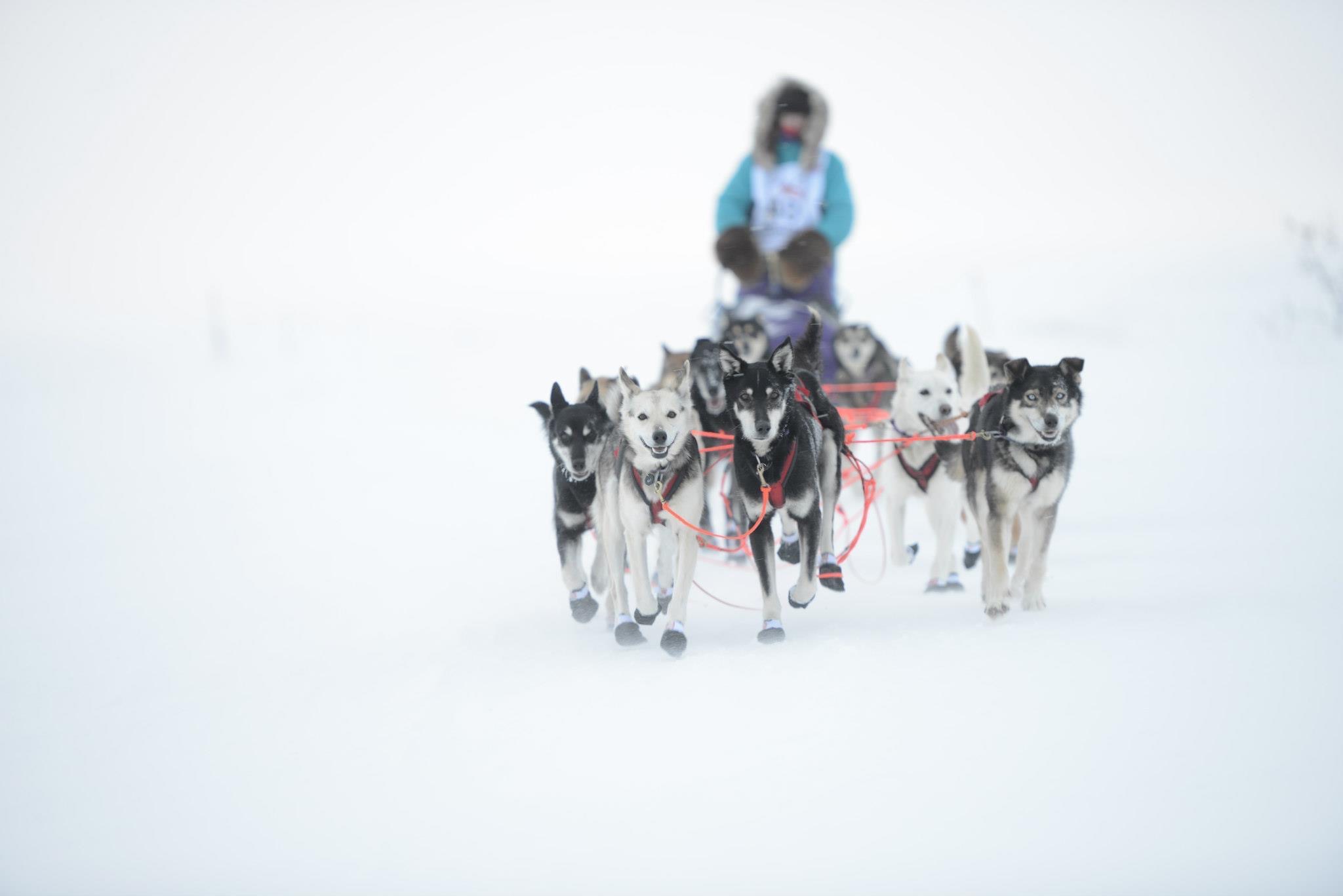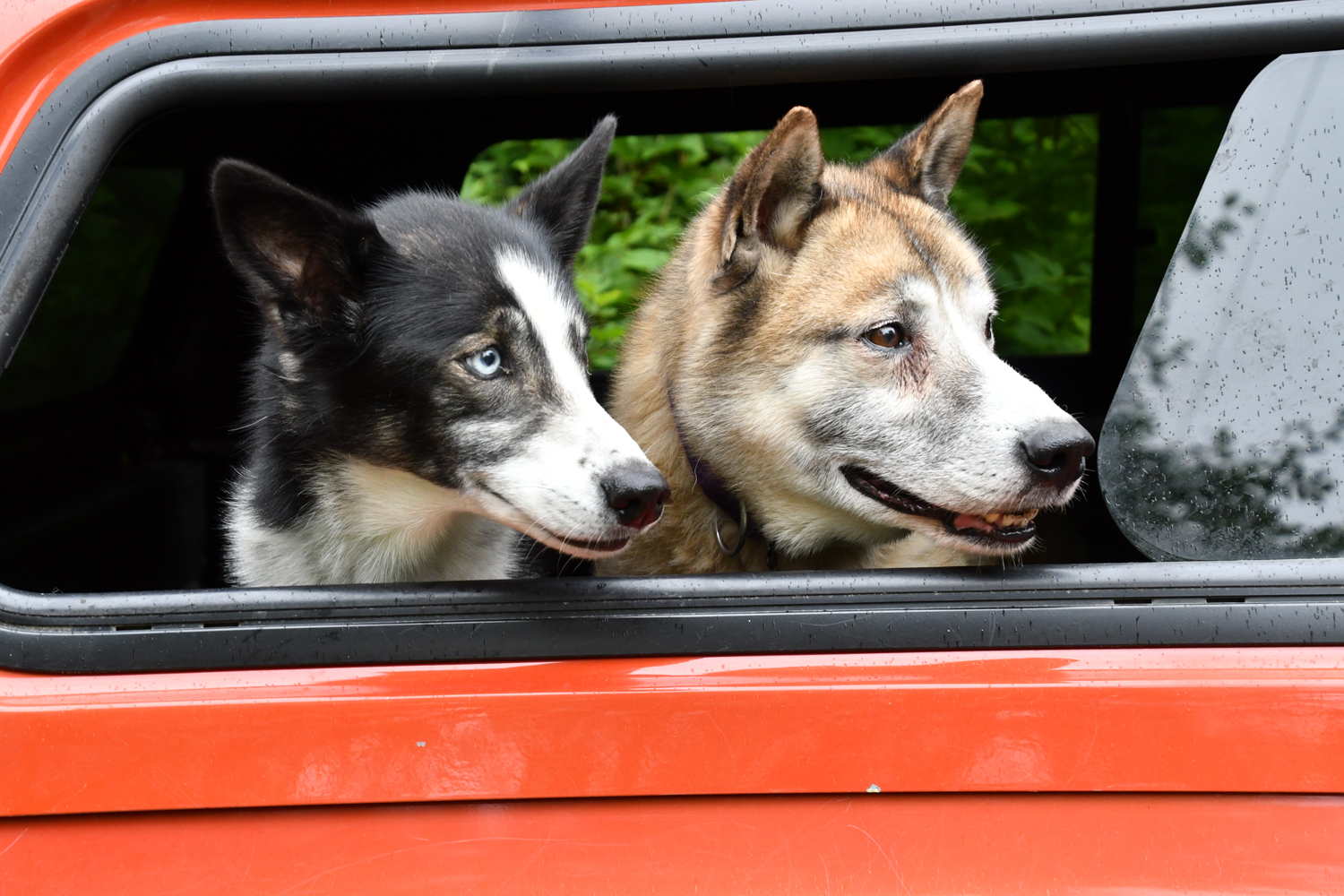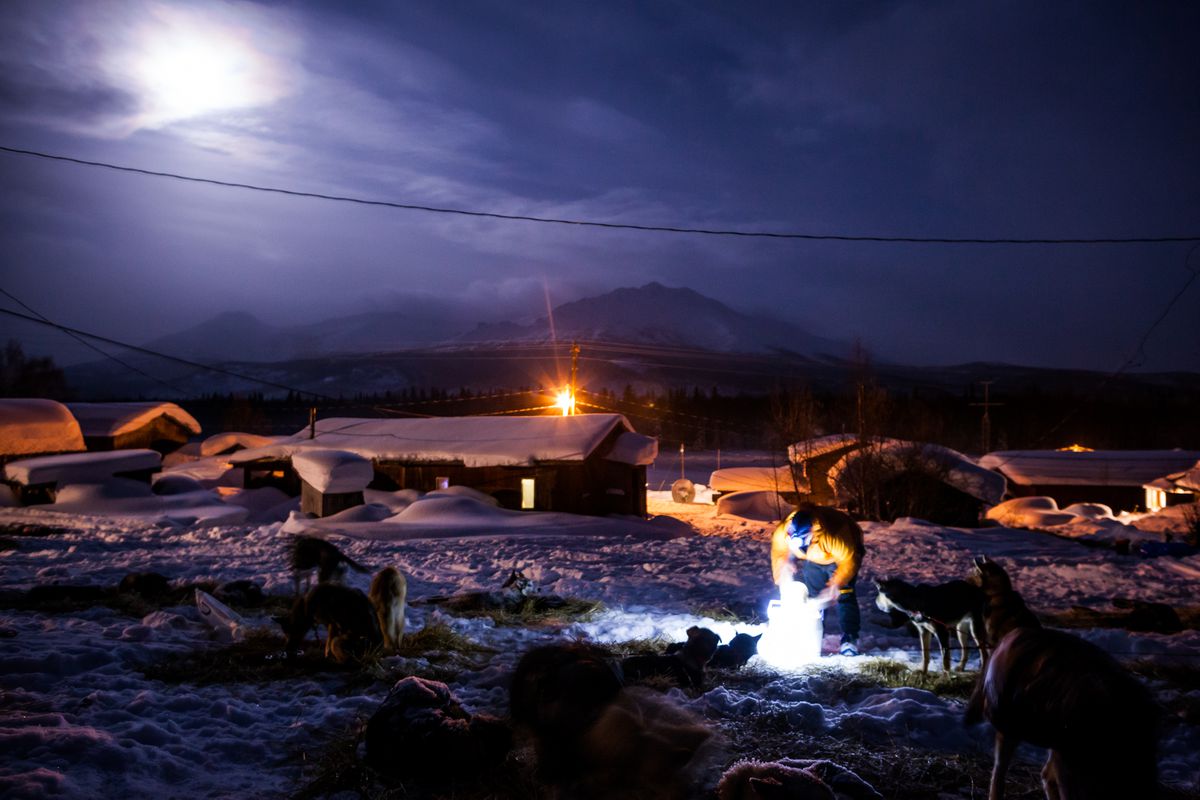Recently my search for blue highways and good stories took me to the island town of Ketchikan, Alaska. Drawing its name from the Tlingit Indian tribe language, Ketchikan translates into “Thundering wings of an eagle.” Its name offers more than a hint of its character. A single road stretches the length of Ketchikan and it is the bluest of highways. A town of mostly rough structures reminiscent of old seaports, diverse cultures and an annual rainfall of 14 feet, Ketchikan clings tenaciously to the rugged granite face of Revillagigedo Island. For those who call it home, it seduces their love of nature and fully challenges their determined countenance to withstand winter’s fury. Stories are many. I have captured a few.
One such story is that of an engaging and cheerful mother and third grade math and science teacher who possesses world class street creds as an experienced “musher’ with multiple finishes in Alaska’s brutal 1,000-mile “Iditarod Trail Sled Dog Race.”
Meet Angie Taggart.
35 Below, 16 Dogs, 13 Days. Angie tackles Alaska’s Iditarod

Angie Taggart at Iditarod
Called by many the “Last Great Race” on the planet, the Iditarod draws a rare and hardy breed of men, women and dogs to a starting line on the first Saturday in March that begins a thousand mile race across a frozen trail from the ceremonial start in Anchorage to Nome during the bitter and cruel Alaskan winter.

Angie, her father John and Iditarod fan who made highest bid at fundraiser for a ride with the team
Meeting Angie Taggart does not immediately instill a sense of being in the company of a daredevil looking to test her physical and mental limits against one of the most punishing environments on earth. Making her acquaintance affords one an immediate sense of being in the presence of a woman both genuine and likeable. A ready smile and a sharp mind leave no doubt that she has the qualities of an excellent teacher. That she has the guts, courage and physical prowess to conquer the Iditarod, twice, not so much. However, in conversing with Angie you gain both a sense of a quiet and powerful resolve and an inherent “can do attitude” completely devoid of bravado. In embracing a challenge Angie displays a power of intention as rugged as the island she has called home since the age of five. One likes her right away.

Angie Taggart at Iditarod in 2013
After graduating from college in 1998 with a degree in education, Angie decided to seek a teaching job in the Alaskan “Bush” country. Bush Country earns its definition by being accessible only by boat or plane. No highways, not even blue ones, can get you there. From out in the Bush, Pikta’s Point, Alaska responded to young Angie’s job search. Isolated on the Yukon River with a young population hovering just over 100 souls, Pitka’s Point became Angie’s new home. As fate would have it, Angie’s fellow teachers each year would charter a plane and fly to Nome to witness the end of the Iditarod Race. While Angie knew the Iditarod ranked at the top of Alaskan sporting events, sled dogs were not part of her experience growing up. That would soon change.
The word “Iditarod” has its roots in the Ingalik Indian word “Haiditarod” which was the name for the river on which the, now, ghost town, “Iditarod, stood. It means “far distant place.” Today, while the town Iditarod is gone, the trail that bears its name remains an integral part of the great race. The Iditarod actually encompasses many trails that started in Seward and ended in the “gold boom” birthed town of Nome.
First run in 1973, the Iditarod owes its existence to many but none more so than Dorothy G Page, the Mother of the Iditarod, and Joe Redington Sr., the father of the Iditarod. Page, not an Alaska native, became president of the Wasilla-Knik Centennial Committee in charge of coming up with an event for 1967 to celebrate the 100th anniversary of Alaska’s purchase from Russia. She originated the idea of a dog sled race that in 1967 covered 56 miles. Out of subsequent conversations with native Alaskan, experienced musher and kennel owner Redington the idea of the 1000 mile Iditarod came to life.
Deeply disturbed in the 1950s by the “Iron Dog’s” (snowmobiles’s) displacement of the dog sled, Redington dedicated himself to preserving the sled dog as part of Alaskan culture and having the Iditarod recognized as a National Historic Trail.
THE RACE
Covering a total distance of over 1000 miles, the distance traveled as the crow flies, is about 650 miles. Conditions facing all participants can include howling winds, blinding blizzards, sub-zero temperatures and emotionally punishing loneliness. Completion times range from 9 to 13 days.
Twenty six checkpoints exist along the 1000 plus mile trail. Here mushers can stop to rest themselves and their dogs, eat, and get their dogs checked. However, when it comes to mandatory “pit” stops only one 24-hour stop and two 8-hour stops are required.
THE DOGS
Original sled dogs from a century ago with their thick necks and chests weighing about 80 pounds descended from wolf stock bred by the Malamute Indians. The breed would later be known as Malamutes. Interestingly today’s Iditarod sled dogs, known as Alaskan Huskies, are crossbred for speed and endurance with weights in the 35 to 65 pound range. Breeding sled dogs with greyhounds is not unheard of. On the trail dogs will burn 10,000 to 12,000 calories a day. All wear protective booties to prevent cuts and abrasions from jagged ice.

An Iditarod musher will start with 12 to 16 dogs. During the race if a dog gets hurt or a rest stop veterinarian judges that a dog is not fit to continue, the dog will be removed from the team, not to return. The dog cannot be replaced. All dogs have a microchip implanted to confirm proper identification. Any dog removed from a team is returned to Anchorage and after being checked in is transported to the Eagle River Correction Institute where designated inmates care for the dog until the musher’s handlers arrive to take the dog home.
Like people dogs have distinct personalities. The smartest and fastest possessing an instinct for navigating a trail become “lead” dogs. Dogs gifted with the ability to best handle curves become “swing” dogs and literally follow the leaders. Closest to the sled can be found the largest and strongest dogs called “Wheel” dogs. Much like a collegiate sculling crew every member plays an indispensable role in creating a complete and competitive team.
For Angie what started as a fling with friends to share a novel experience morphed into a life changing passion. Quickly she and her friends joined the legion of volunteers who helped with the dogs. Angie says, “I immediately just fell in love with the whole lifestyle of being out and about in nature with the dogs.” By her second year at the Iditarod Angie knew she would be leaving teaching at Pitka’s Point.
In realizing that she had no obligations or plans for that matter, Angie decided to explore the possibilities available for being an Iditarod sled dog handler. Angie says, “Most of my friends responded with a Mr. Spock-like raised eyebrow and an, okay, whatever.” Angie’s first move called for approaching a woman musher and Iditarod veteran whom she truly respected, Dee Dee Jonrowe. Jonrowe had run the Iditarod 30 times and finished second overall three times. In describing the toll taken by a sport she loved, Jonrowe was quoted as saying, “I’ve had back surgery, frozen my shoulder, broken my hand…I think I’ve had every single cold related injury. I haven’t had any amputations, but I have had severe frostbite on my fingers, cheeks and nose. I even frostbit my corneas some years ago”.

DeeDee JonRowe
When Angie asked Jonrowe what she needed to do to become a dog handler, Jonrowe basically responded, “Do you have a strong back?” Angie said “yes” and Jonrowe replied, “Call me in two weeks.” Two weeks later in the spring of 2000, DeeDee invited Angie to her facility in August to be her dog handler. Working with Jonrowe and her 100 dogs, Angie fell in love with the life and developed a driving passion to run the Iditarod.
After completing her year with Jonrowe, Angie returned to Ketchikan, and had the great good fortune to share her dream with a friend, an older woman who felt convinced that Angie had what it took to achieve her dream to run the Iditarod. The woman said, “You’re going to do this one day and I am going to support you. I am going to get you there.”
Angie says, “It takes a lot more than desire to be in the race. You have to run qualifying races totaling 500 miles.” Most of those miles would take place under the close scrutiny of race officials filling out a report card to confirm the musher’s fitness to handle the Iditarod challenge. Prior to qualifying Angie met with a friend, Ray Redington, yes, the grandson of Iditarod Icon, Joe Redington. He agreed to let her use his dogs for the qualifying races. Angie got a great report card. This gave her two years to run the Iditarod before she would have to requalify.

Sled dogs Willow and Chip
Unable to get an unpaid leave of absence from her teaching position in 2010, Angie set her sights on 2011.
With her leave granted for 2011, it was game on. Angie bought the team she would run from another of Joe Redington’s grandson’s, Ryan Redington.
Angie trained through the summer in races with the team pulling a 2,000 pound sled on wheels. When asked how she personally trained to be in shape, Angie says, “Just working with the dogs. I lost so much weight and gained so much muscle mass just by lifting 50 pound bags of dog food and lifting and repositioning dogs. Trust me it was a strenuous task. Physically I was ready.”
March 6th, the race started at 1:00 o’clock. Entrants pull a bib number (the number the musher would wear) from a boot to the sequential starting order. Each entrant had two minutes to start or go to the end of the queue. A few nights earlier Angie had drawn bib number 19.

Nobody cracks a whip or yells mush to start the team. Pretty much “Let’s go” gets the team off and running. Weather a 200-pound musher or a 110-pound musher, it does not matter. No attempt is made to equalize weights. The weight of the sled is the sum of you and what you choose to bring. Angie says, “The combined weight for me and the sled was 300 pounds. That may sound like a lot but snow offers little friction and the weight per dog with 16 dogs is less than 20 pounds.”
Once at full stride Angie describes her dogs as “racing machines.” At the start I had 16 dogs and, at times, would leave my sled and run along side to lighten their load. By the end of the race I had 12 dogs and never left the sled even on hills. More than half the time Angie would sleep with her dogs using her -40 degree F sleeping bag. Only when her clothes had gotten soaked would she spend the night indoors as her clothes dried.

Conditions on the trail would see temperatures drop to -35 degrees F. These temperatures demanded that coats be put on the dogs. Yet, at other times conditions suffered from water pooling on top of ice. At the Yukon River Angie experienced a total whiteout with blizzard conditions and 35 mph winds. Angie says, “That was the only time I thought I was not going to finish the race. I could not find a dog that would lead.” Angie notes that dogs act much like people. Sometimes a highly qualified individual facing a challenge fails to measure up. In the face of the blizzard all dogs wanted to turn back. Then one dog, ten-year old Carmack, stepped up as a single lead and took the team through. Maybe he should be renamed Rudolph (OK, bad joke).
After thirteen days, Angie Taggart and her team pulled into Nome Alaska. Of the 64 teams that started, 47 finished. In her first Iditarod Angie and her team finished 43rd.
When asked what did this experience mean to her Angie says, “I would say just the opportunity to be able to do this. More people have summited Mount Everest than have finished the Iditarod.”

Love the story and love Alaska! I actually have been invited to attend this race next year! I just may do it after reading this!!
I hope you go. It should be great fun and I would be pleased if I helped motivate you to attend.
Hey Burton!
What a great story. What a great accomplishment, finishing that race. ..even starting that thing. I thought the Midnight Run was tough. You packed a lot of information into that article. Many thanks.
When are you buying your sled and dogs?
Thank you for the great compliment. If you hear I am buying a sled and dogs I assure you that that is a lot of mush.